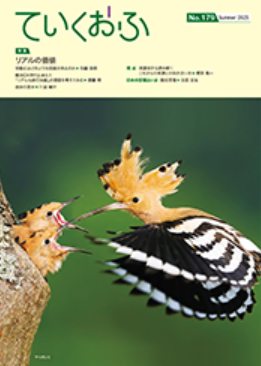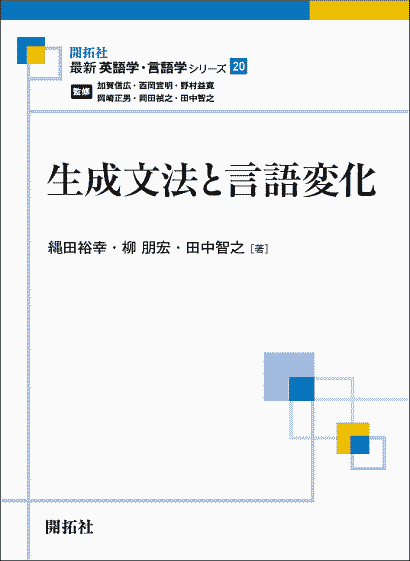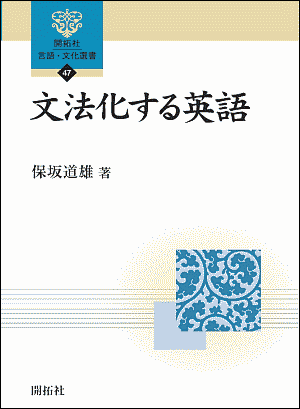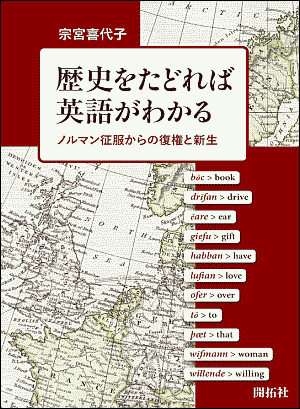2025-12-03 Wed
■ #6064. 「いのほた言語学チャンネル」で言語変化における「見えざる手」仮説を解説しました [notice][invisible_hand][language_change][causation][link]
11月30日(日)に公開された「いのほた言語学チャンネル」の最新回で「#390. 言語はなぜ変化するのかにもいろいろ説があるが,この仮説,納得!?」をお届けしました.hellog でもたびたび取り上げてきた,言語変化に関する「見えざる手」仮説 (invisible_hand theory) について導入した回となります.
皆さん,高速道路などで事故も工事もないのに発生する「謎の渋滞」に巻き込まれたことがあるかと思います.英語ではこれを traffic jam out of nowhere と呼ぶのですが,実はこの現象と言語変化のメカニズムには,驚くべき共通点があるのです.
動画では,この理論を提唱した Rudi Keller の考えに基づき,まずはこの交通渋滞の例え話から解説を始めています.先頭の車がふとした拍子に少し減速すると,後続車は衝突を避けるために安全マージンをとって,前の車よりも少し強めにブレーキを踏みます.これが後ろへ後ろへと連鎖していくとどうなるか.最終的には完全停止し,その後続車の一群は渋滞にはまる,という誰も望んでいなかった結果が生まれてしまうのです.
ここで重要なのは,ドライバーの誰も「渋滞を作ってやろう」などとは考えていないという点です.1人ひとりは安全に走りたいという合理的な動機で行動しているだけにもかかわらず,小さな行動が集団的に蓄積すると,個人の意図とはかけ離れて,渋滞という社会的な現象が引き起こされてしまいます.この「ミクロな個人の意図」と「マクロな全体の結果」の間にあるパラドックスこそが,「見えざる手」と呼ばれるものの正体です.
そして,これは言語の変化にもそのまま当てはまります.私たちも普段,「日本語の文法を変えてやろう」とか「英語の発音を歴史に残るように変化させよう」などという意図をもって言語を使用しているわけではありません.ただ,目の前の相手にうまく伝えたい,あるいは少し楽に発音したいなどとと思いつつ,日々の言葉を発しているだけです.しかし,そうした無意識の微調整の機会が積み重なり,多くの人々に伝播していくと,数十年,数百年というスパンで見たときに,大きな言語変化となって現われるのです.
動画内では,井上さんとの対話を通じて,この意図せざる結果がいかにして生じるのか,一見するとブラックボックス的な「見えざる手」の仕組みについてお話ししています.
アダム・スミスが経済学で説いた「神の見えざる手」が,まさか言語学に応用できるとは,と意外に思われるかもしれません.しかし,言語変化を説明する1つの有力な仮説ですので,ぜひ動画本編でそのロジックを楽しんでいただければと思います.
なお,このテーマについては hellog の過去記事でもたびたび取り上げてきました.動画を観て,もう少し理論的な背景を知りたいと思われた方は,ぜひ invisible_hand のタグの付いた記事群,そのなかでもとりわけ以下の記事を合わせてお読みいただければ.
・ 「#8. 交通渋滞と言語変化」 ([2009-05-07-1])
・ 「#2539. 「見えざる手」による言語変化の説明」 ([2016-04-09-1])
・ Keller, Rudi. On Language Change: The Invisible Hand in Language. Trans. Brigitte Nerlich. London and New York: Routledge, 1994.
2025-09-10 Wed
■ #5980. 「言語変化は雨樋に従う」 [language_change][metaphor][conceptual_metaphor][language_myth][historical_linguistics]
Burridge and Bergs が,言語変化論の書籍の最後で,Kuryłovicz を引用しながら,言語変化 (language_change) をめぐる印象的な比喩 (metaphor) を紹介している.すぐれた比喩なので,その部分を引用したい.
10.5 WHERE TO FROM HERE?
As we have emphasized throughout this book, change schemas . . . do not follow prescribed courses determined by exceptionless laws or principles, but it is possible to talk about preferred pathways of change --- those "gutters" that channel language change, to use that image famously invoked by Kuryłovicz (1945). Referring specifically to analogical change, Kuryłovicz likened these developments to episodes of rain. While we may not be able to predict when it will rain, or even if it will, once the rain has fallen, we know the direction the water will flow because of gutters, drainpipes and spouting. An important goal of historical linguistics is thus to gain a clearer picture of these "gutters of change", in other words, to refine our notions of natural and unnatural change . . . . (272)
雨樋でも雨水溝でも排水路でもよいのだが,これらは雨水の流れる道筋を決める.言語変化にもまた流れやすい道筋があり,それを突き止めるのが歴史言語学の重要な目的なのだという.雨と同様に言語変化がいつ起こるかは分からない.また,ときには通常の道筋から外れることもあるだろう.しかし,言語変化の雨樋を探るのが言語変化論者の仕事であると.
言語(変化)に関する様々な比喩については,「#4540. 概念メタファー「言語は人間である」」 ([2021-10-01-1]) とそこに挙げたリンク先を参照.
・ Burridge, Kate and Alexander Bergs. Understanding Language Change. Abingdon: Routledge, 2017.
・ Kuryłovicz, Jerzy. "La nature des procès dits 'analogiques'." Acta Linguistica 5 (1945): 15--37.
2025-09-08 Mon
■ #5978. ONZE --- Origins of New Zealand English Project [link][new_zealand_english][variety][language_change][bibliography]
ニュージーランド英語 (new_zealand_english) の起源を探る調査が1980年代後半から活発化してきている.その中心的な役割を果たしてきたのが ONZE (Origins of New Zealand English Project) というプロジェクトだ.ニュージーランドのカンタベリ大学が拠点となっている.
Williams (1998--99) による簡単な紹介を読んでみよう.
For the origins of the New Zealand accent, a unique set of data are available in the form of recordings made throughout rural New Zealand in the 1940s, among them some of the first New-Zealand-born speakers of English which allowed people on the Origins of New Zealand English Project (ONZE n.d.) to document the embryonic stages of the New Zealand accent.
ONZE の調査とその成果については,Gordon (et al.) や Trudgill の一連の研究が詳しい.以下に主要な論著の書誌を挙げておく.
・ Gordon, Elizabeth. "That Colonial Twang: New Zealand Speech and New Zealand Identity." Culture and Identity in New Zealand. Ed. David Novitz and Bill Willmott. Wellington: GP Books, 1989. 77--90.
・ Gordon, Elizabeth. "The Origins of New Zealand Speech: The Limits of Recovering Historical Information from Written Records." English World-Wide 19(19): 61--85.
・ Gordon, Elizabeth and Andrea Sudbury. "The History of Southern Hemisphere Englishes." Alternative Histories of English. Ed. Richard Watts and Peter Trudgill. London: Routledge, 2002. 67--86.
・ Gordon, Elizabeth, Lyle Campbell, Jennifer Hay, Margaret MacLagan, Andrea Sudbury, and Peter Trudgill. New Zealand English: Its Origins and Evolution. Cambridge/New York: Cambridge UP, 2004.
・ Trudgill, Peter. Dialects in Contact. Oxford: Blackwell, 1986.
・ Trudgill, Peter. "A Window on the Past: 'Colonial Lag' and New Zealand Evidence for the Phonology of Nineteenth-Century English." American Speech 74(3): 227--39.
・ Trudgill, Peter. New Dialect Formation: The Inevitability of Colonial Englishes. Edinburgh: Edinburgh UP, 2004.
・ Trudgill, Peter, Elizabeth Gordon, Gillian Lewis, and Margaret Maclagan. "Determinism in New-Dialect Formation and the Genesis of New Zealand English." Journal of Linguistics 36: 299--318.
・ Williams, Colin H. "Varieties of English: Australian/New Zealand English." Chapter 127 of English Historical Linguistics: An International Handbook. 2 vols. Ed. Alexander Bergs and Laurel J. Brinton. Berlin: Mouton de Gruyter, 2012. 1995--2012.
2025-08-05 Tue
■ #5944. 非従位化 --- 従位節の独立・昇格 [insubordination][syntax][conjunction][subordinator][language_change][terminology][may][pragmatics][speech_act][word_order][inversion]
接続詞 (conjunction) の歴史を調べるのに Fischer et al. を参照していたところ,非従位化 (insubordination) という興味深い過程を知った (187) .従位接続詞に導かれる従位節が,主節を伴わずに独立して用いられる場合がある.
Sometimes clauses with the formal markings of subordination are used without a proper main clause --- which is what Evans (2007) refers to as 'insubordination'.
(70) O that I were a Gloue vpon that hand (Shakespeare, Romeo & Juliet, II.2)
It is typical for such insubordinate clauses to come with specialized functions --- the insubordinate that-clause in (70) expresses a wish. It is still an unresolved issue, however, exactly how insubordinate clauses originate and develop, and how formal and functional change interact in this.
これは,May the force be with you! のような祈願の の用法の発達の議論にも関わる重要な洞察だ.may の構文は,従位接続詞を伴わず倒置という手段により従位節を作っているかのようで,その点では少々変わったタイプではあるものの,祈願という「特殊化した機能」をもつ点で類似している.非従位化の事例間の比較研究はあまりなされていないようだが,発達の仕方には共通点があるのかもしれない.関連して「#5937. 従位接続詞以外に従位節であることを標示する手段は?」 ([2025-07-29-1]) も参照.
・ Fischer, Olga, Hendrik De Smet, and Wim van der Wurff. A Brief History of English Syntax. Cambridge: CUP, 2017.
2025-07-05 Sat
■ #5913. これまでの音変化理論は弱い公式化にとどまる [history_of_linguistics][sound_change][phonetics][phonology][causation][language_change]
言語変化のなかでも音変化を説明することはとりわけ難しい.言語学の歴史において,「音変化理論」なるものはあるにはあるのだが,あくまで弱い仮説にとどまる.なぜ言語音は変化するのか? ある音変化が起こったとして,なぜそれはそのときに起こったのか? 音変化はある条件のもとに起こるのか,それとも無条件に起こるのか? 疑問を挙げだしたらキリがない.これらのいずれも満足に解決していないといってよい.
『音韻史』を著わした中尾は,その冒頭に近い「1.2 音変化理論」の最初に,次のように述べている.
19世紀以降の史的言語学の発達とともに「なぜ音は変化するか,それを引き起こす要因は何か」という問題が史的言語学にとって重要な関心の1つとなった.今世紀前半の記述言語学,後半からの変形生成理論等の言語理論の目ざましい発展とともに色々な変化理論が提案されてきた.変化理論は究極的には一定の時間内に起こる言語変化のおそらく複数の直接的原因を究明し,さらにそれを予知することにあるが,今日までの研究は主として言語変化への制約の公式化という弱い形をとっている.すなわち,音変化の要因を,言語的,社会的,心理的,生理的要因に求め,文脈依存の変化について文脈の研究が,文脈自由の変化については外的および内的要因の研究が行なわれてきた.
『音韻史』が書かれたのは1985年だが,それから40年経った今でも,上述の状況は本質的に変わっていない.英語史の音変化の各論においても,もちろん様々な考え方や理論は提案されてきたものの,「主として言語変化への制約の公式化という弱い形をとっている」状況に変わりがない.
私見では,言語変化のなかでも,とりわけ音変化は最後まで謎のままに残るタイプなのではないか.だからこそ引きつけられるものがある.
・ 中尾 俊夫 『音韻史』 英語学大系第11巻,大修館書店,1985年.
2025-07-01 Tue
■ #5909. 「英語史から読み解く これからの英語との向き合い方」 --- ANAの季刊誌『ていくおふ』第179号に掲載されています [notice][hel_education][helkatsu][standardisation][world_englishes][variety][variation][language_change]

【 はじめに 】
このたび,ANAホールディングズが発行する季刊誌『ていくおふ』第179号(2025年夏号)に,「英語史から読み解く これからの英語との向き合い方」と題するエッセイを寄稿いたしました.作り込んだ図表を含む8ページにわたる,中身の詰まった記事です.
なぜ航空業界の発行する雑誌に「英語史」の話題が,と驚かれた方もいらっしゃるかもしれません.私も寄稿のお話をいただいたときには少し考え込んだのですが,航空といえば国際性,国際性といえば英語ですので,思ったよりも大きな飛躍はありません.考えているるうちに,むしろ英語史的な視点を導入するのにうってつけの機会ではないかと感じ始めました.
【 「標準英語」はいつから標準だったのか? 】
今回の記事では,1500年以上にわたる英語の歴史をふり返りながら,「標準化」と「脱標準化」という2つのベクトルのせめぎ合いに注目しました.英語はその誕生以来,外部の言語と接触し,地域的・社会的・文化的な要因によって常に姿を変えてきた言語です.
例えば中世の英語は,現代のような「正しい英語」という規範が存在しない,きわめて多様な状態にありました.ある時代にはフランス語に押されて地位を失いましたし,またある時代には,印刷術や教育制度の普及によって「標準英語」が形成されていくことになりました.しかし,それはロンドンの中・上流階級の言葉遣いをモデルにした,ふわっとして捉えどころのない虚構的な代物にすぎませんでした.
【 「世界諸英語」の時代へ――英語の多様性は今に始まったことではない 】
英語は紆余曲折を経て世界語となりましたが,一方でいまだに多様性に満ちた言語でもあります.現代の私たちは,アメリカ英語やイギリス英語だけでなく,インド英語,シンガポール英語,ナイジェリア英語など,英語の多様な「顔」と日常的に向き合っています.訪日観光客の増加や国際交流の進展によって,日本に暮らしながらも多様な英語に触れる機会が増えてきたので,この現状は理解するのに難しくないはずです.
様々な英語を聞いて「これって正しい英語なの?」と戸惑う場面もあるかもしれません.しかし,英語史をふり返ると,そうした多様性はむしろ英語本来の姿だとわかります.一度たりとも均質だったことはなく,むしろ常に揺れ,変わり続けてきた言語なのです.
この認識こそが,現代のグローバルな言語状況を読み解く上での出発点になります.
【 これからの英語との付き合い方とは? 】
本エッセイの締めくくりでは,こうした歴史的背景を踏まえたうえで,現代を生きる私たちが英語とどのように向き合うべきかについて,4点を指摘・提案しました.
1. 絶対的な「正しい英語」は存在しない
「標準英語」とは,歴史的・社会的に構築された規範であり,それ自体が一つの変種にすぎません.英語(ひいては言語)の本質は常に変化と多様性にあります.
2. 状況に応じた柔軟な運用がカギ
書き言葉/話し言葉,フォーマル/インフォーマルなど,目的に応じてスタイルを使い分ける力が求められます.「どれが正しいか」ではなく,「何が適切か」を見極める視点が大切です.
3. 多様な英語変種への寛容性と理解
世界中の非母語変種の英語に触れたとき,違和感や誤用と断ずる前に,その背景と特徴に目を向けることが重要です.
4. 英語史からの学び
発音と綴字の乖離,語彙の多さ,文法のゆれなど,英語の「なぜ?」に,たいていの場合,上手に答えてくれるのは「英語史」です.英語の歴史を知ることで,英語への視野が広がります.
英語が「世界の言語」としてさらに多様化し続けるなか,私たちはどのようにその変化とつき合っていくべきなのか.そのヒントを,英語史という長いスパンから探ってみませんか? 興味を持たれた方は,ぜひ本誌をお手に取ってみてください.
【 雑誌『ていくおふ』について 】
本エッセイは,ANAによる『ていくおふ』という季刊誌の記事として掲載されています.今回ご紹介した記事のほかにも,空間認知と建築体験に関する記事や,空港の地理学的考察などに関する記事をなども掲載されています.
『ていくおふ』第179号をご希望の方は,公式HPより詳細をご確認ください.ANA公式スマホアプリからも入手可能となっております.
なお,今回のエッセイについては,heldio にて「#1490. 「英語史から読み解く これからの英語との向き合い方」 --- ANA『ていくおふ』179号より」として配信していますので,そちらもぜひお聴きください.
・ 堀田 隆一 「英語史から読み解く これからの英語との向き合い方」『ていくおふ』第179号(2025年夏号),ANAホールディングズ.2025年5月.33--40頁.
2025-06-21 Sat
■ #5899. 「クレイフィッシュ語」? --- ヘルメイトさんたちによる用語開発 [folk_etymology][disguised_compound][contamination][analogy][language_change][lexicology][paramorphonic_attraction][haplology][terminology][helmate][helvillian][helville][helkatsu]
heldio/helwa のコアリスナーでヘルメイトの mozhi gengo さんが,今朝ご自身の note で「#233. 跳ねてウィンクする鳥? lapwing」を公開されている.そこで crayfish 「ザリガニ」や lapwing 「ケリ(鳥)」という英単語のメイキングに隠されている語形変化を指摘しつつ,このような語を「クレイフィッシュ語」と名付けている.民間語源 (folk_etymology) や偽装複合語 (disguised_compound) の1種といってよい形態音韻変化だが,その結果として生まれた語を「クレイフィッシュ語」と名づけているのが,とても親しみやすい.
mozhi gengo さんによる今回の記事と提案は,同じくヘルメイトの lacolaco さんによる最新の note 記事「英語語源辞典通読ノート C (crayfish-creature)」から洞察を得たものと想像される.crayfish の cray とは何か,と思うかもしれない.しかし,この語に関しては,cray が意味不明なだけでなく,fish も魚とは無関係なのだ.この語は古フランス語の crevice に由来し,中英語で crevise として借用されたが,語幹の一部である vise の方言的異形 vish が契機となって,最終的に fish と誤って解釈されるに至ったということだ.音形の似た別の既存語に引っ張られて,crevice が crayfish にまで化けてしまったということになる.ちなみに,究極的には語源が crab 「カニ」にも関わるというからおもしろい.
何よりも lacolaco さんの話題提供,そして mozhi gengo さんの洞察という流れがたまらない.ヘルメイトさんたちが話題をつなげて,「クレイフィッシュ語」というタームの創出に至ったわけだ.
改めてお2人の着眼点の鋭さに注目したい.ここで議論されている現象は,私が以前 hellog で取り上げた「#5840. 「類音牽引」 --- クワノミ,*クワツマメ,クワツバメ,ツバメ」 ([2025-04-23-1]) と同じものである.そこでは,日本語学における「類音牽引」という用語を使ったのだった.これは「ある語が既存の語の音に引きずられて変化する現象」を指す.先の記事では,富山県の方言における「桑の実」を表す語が,「ツバメ」という既存の語に引っ張られて「クワツバメ」へ,さらには「ツバメ」へと変化していく過程を紹介した.
この「類音牽引」は,英語の専門用語としては直接対応するものがなく,先の記事では Fertig より confusion of similar-sounding words (61) といった説明的な句を引用するにとどまった.英語の用語不足には不満が残っていたのである.そんな折に,別のヘルメイトのり~みんさんが,note にて 「類音牽引って例えば paromophonic attraction みたいな造語は可能なのだろうか?」〔ママ〕とつぶやかれたのである.これまた見事なタームの造語である."paramorphophonic attraction" から pho の重音脱落 (haplology) を経て,"paramorphonic attraction" と持ってきたわけだ.
ヘルメイトの皆さんは,異能集団である.
・ Fertig, David. Analogy and Morphological Change. Edinburgh: Edinburgh UP, 2013.
2025-05-30 Fri
■ #5877. 発音とアクセントはどう移ろうか --- 水野太貴さんによる『中央公論』の連載より [yurugengogakuradio][notice][language_change][dialect][dialectology][stress][pronunciation][sound_change][japanese][phonetics][heldio]

今年度,興奮をもって追いかけている連載があります.言語学系 YouTube/Podcast チャンネル「ゆる言語学ラジオ」の水野太貴さんが,『中央公論』にて「ことばの変化をつかまえる」と題して執筆されているシリーズです.言語変化 (language_change) という,ともすれば専門的で敬遠されがちなテーマに光を当て,第一線の研究者へのインタビューを通じてその核心に迫ろうという,野心的な企画です.今年度は毎月本誌の発売を心待ちにするという習慣がついてしまいました.
連載第3回となる最新6月号では「発音とアクセントはどう移ろうか --- 歴史言語学者・平子達也さんに聞く」と題して,言語変化のなかでも特に根源的といえる音変化 (sound_change) が扱われています.私自身,英語史研究のなかで音韻や形態の変化を主たるフィールドとしてきただけに,今回のテーマにはとりわけ深い関心を抱きました.そして期待に違わず,今回の記事は心に深く刺さるものがありました.
音変化は言語変化における最大のミステリーである,と私は考えています.語彙や文法の変化も謎に満ちていておもしろいのですが,言語活動の基盤となる「音」が,なぜ,どのようにして変わるのかという問いは,最も捉えがたく,そして魅力的な謎なのです.専門家ですら説明に窮することの多いこの難題に,水野さんは南山大学の平子達也先生へのインタビューを通じてグイグイ迫っていきます.専門性の高いトピックをこれほど分かりやすく導入している文章を,私はあまり読んだことがありません.
記事は「なぜ発音は変わるのか」という素朴な疑問から始まります.平子先生は,その主要な動機の1つを「調音器官のスムーズな運動」への欲求,すなわち発音を楽にしたいという話者の都合に求めます.これは言語学で「最小努力の原則」 (The Principle of Least Effort) といわれているものです.私たちは無意識のうちに,発音を楽な方へと変化させている,というわけです.
しかし,もしこの原則だけが支配的ならば,すべての発音はどんどん簡略化され,例えば母音はすべて曖昧母音に収斂してしまうでしょう.すると,コミュニケーションの道具として機能不全に陥ってしまうはずです.しかし,現実はそうなっていなません.そこに「歯止め」となる力が働いているからです.
この点について,平子先生は次のように指摘されています (p. 171) .「言語というのは音だけで成るわけではありません.単語や文法など,ほかの体系と密接にかかわっていますから,それらとの兼ね合いで,一方向には進まないという事情があります.」
確かに音は語彙や文法といった言語体系の他の構成要素と固く結びついています.そして,平子先生は音変化の本質を次のように喝破します (p. 172) .「つまり発音の変化は,調音上の都合でラクしたいという動機と,その他の構成要素の制約のあいだで緊張関係を保ちながら起こるわけです.」
「緊張関係」という一言に,音変化のダイナミズムが凝縮されていますね.一方に引っ張る力と,それに抗うもう一方の力.その拮抗のなかで,言語は常に揺れ動き,姿を変えていきます.この記事は,その複雑なプロセスの存在を専門家でない読者にも実感させてくれます.ぜひ皆さんにこの記事を直接読んでいただければと思います.
今回ご紹介した記事は heldio でも「#1459. 音変化のミステリー --- ゆる言語学ラジオの水野太貴さんの『中央公論』連載「ことばの変化をつかまえる」より」として紹介しています.お聴きいただければ.
・ 水野 太貴 「連載 ことばの変化をつかまえる:発音とアクセントはどう移ろうか --- 歴史言語学者・平子達也さんに聞く」『中央公論』(中央公論新社)2025年6月号.2025年.168--75頁.
2025-05-11 Sun
■ #5858. 言語において変わるものと変わらないもの --- 「いのほた言語学チャンネル」より [inohota][youtube][language_change][historical_linguistics][notice][christianity][oe][loan_word][borrowing]
同僚の井上逸兵さん(慶應義塾大学)と運営している YouTube 「いのほた言語学チャンネル」は,原則として毎週水曜日と日曜日の午後6時に最新回が配信されています.多くの方にご覧いただいています.ありがとうございます.おかげさまで言語学系のチャンネルとして少しずつ知られるようになってきました(チャンネル登録者は目下1.42万人).
1週間前に配信された「#333. 変化したことより変化してないことの方がおもしろい!?新しい歴史言語学」が,思いのほかよく視聴されています.20分ほどの動画です.ぜひご視聴いただければ.
この回のテーマは,本ブログでも中心的に取り上げてきた言語変化 (language_change) です.言語は常に揺れ動き,時代とともにその姿を変えていきますが,その一方で,変化しない要素も存在します.今回の動画では,この言語変化のダイナミズムと,その陰に潜む不変性に焦点を当てました.
まず言語変化研究の現状を概観し,歴史言語学 (historical_linguistics) における伝統的な視点を紹介しています.一般的に,歴史言語学は,ある言語に注目し,その変遷の歴史を追う学問と捉えられています.しかし,言語の歴史を捉える上で重要なのは,変化した事象だけでなく,連綿と受け継がれてきた,つまり変わらなかった事象にも目を向けることであると論じました.
社会や文化が大きく変動する際に,言語もまた影響を受け,発音が変容したり,新しい語彙が生まれたり,既存の語の意味が変わったり,あるいは文法が変化したりします.しかし,その一方で,社会の変化にもかかわらず,従来の形式を保持し続ける言語項目も存在します.動画では,この「不変化」の重要性について,具体的な例を挙げながら議論を展開しました.
特に興味深い例として簡単に触れたのが,英語における God という単語です.古英語期,イングランドにキリスト教が浸透する過程で,多くのキリスト教関連用語がラテン語から導入されました.しかし,「神」という最も根源的な概念を表わす単語は,対応するラテン語の deus を借りるなどではなく,ゲルマン語起源の god が生き残りました.なぜ,他の多くの用語がラテン語によって置き換えられたにもかかわらず,この単語については現代に至るまでその形を保ち続けているのでしょうか.この問いを探ることは,単なる語源研究にとどまりません.言語共同体の文化や歴史に迫ろうとする試みでもあります.以下に関連する過去記事を挙げておきます.
・ 「#32. 古英語期に借用されたラテン語」 ([2009-05-30-1])
・ 「#865. 借用語を受容しにくい語彙領域は何か」 ([2011-09-09-1])
・ 「#1619. なぜ deus が借用されず God が保たれたのか」 ([2013-10-02-1]),
・ 「#2663. 「オープン借用」と「むっつり借用」 (1)」 ([2016-08-11-1])
・ 「#3382. 神様を「大日」,マリアを「観音」,パライソを「極楽」と訳したアンジロー」 ([2018-07-31-1])
動画では,この他にも,言語(不)変化の背後にある力学について触れています.言語は,川の流れのように常に変化していきます.しかし,その川底には,時を超えて変わらない岩盤のような要素も存在しているのです.言語変化という現象を多角的に捉える視点を提供できたのであれば幸いです.
2025-04-29 Tue
■ #5846. 言語地理学 [geolinguistics][geography][terminology][linguistics][dialectology][dialect][language_change][terminology]
本ブログでもいくつかの記事で言及してきたが,言語地理学 (linguistic geography or geolinguistics) という分野がある.「言語学×地理学」といえば真っ先に「方言学」 (dialectology) が思い浮かぶが,言語地理学はそれとは異なる.もちろん両分野は関連が深く,関心領域も重なるのは事実ではある.『日本語学研究事典』より「言語地理学」の説明を読んでみよう.
言語地理学(げんごちりがく) 【解説】方言地理学ともいう.言語と自然・人文地理的環境との関連を考察し,言語変化をあとづけ,その要因を究明し,一方,言語の地理的分布構造を明らかにする科学.言語現象を個別的なものに分解し,それぞれの地理的変異相についての考察から出発する.基礎として次のような想定がある.(1) ある特定の言語現象 A が連続した一定の地理的領域を持つ場合,領域内の各地点の言語現象には,歴史的な関連があったと考える(A分布).(2) 対立する言語現象 AB の領域が地理的に接している場合には,接触点に闘争があり,歴史的に一方が他方を圧迫してきた場合が多いと考える(AB分布).(3) A の二領域の間に,A の領域を分断して B の領域が認められる場合は,例外を除いて,言語記号の音形と意味の結びつきの無拘束性・恣意性の原理によって,B の領域の両端で,無関係に同じ A が生じたとは考えられないとし,歴史的に,古くからの広い A の領域を新しく発生した B が分断して現状が作られたと考える(ABA分布).文化の中心で新しい表現が生じ,それが勢力を得ると,これまでの用語が外側に押しやられる.この種の改新が何度か起こると,新語を使う都市を中心に,距離に応じて幾つかのふるい後を使う地域の輪ができ,古い語ほど中心から遠くに見いだされる.こういう現象を説明するために柳田国男は「方言周圏論」という述語〔ママ〕を用いた.(3) の幾重にも重なった場合のことである.以上は,換言すればことばの歴史的変遷が地理的分布に投影しているという想定である.対象地域は全国域のものから地方・県・郡などを単位とするものまで,いろいろあり得る.言語対象は,語彙的現象を選ぶことが多いが,言うまでもなく,音声・文法現象その他にも及ぶ.地理的な文法状況を材料にすることから,「言語地図の作成」を第一工程とする.地図上である特定言語現象の分布領域の外周を囲む線を「等語線」という.ただし,等語線で囲まれた地域内に,対立する別現象が存在しないというのではない.混在地域があり得るからである.方言を対象とすることから,方言地理学即方言学とする考えがあるが,東条操は,方言学と言語地理学を区別した.藤原与一は,その方言学の体系の一部に方言地理学を位置づける.金田一春彦は個別的現象からはいる「言語地理学」に対して,方言に対する「比較方法」の適用を提唱する.
言語地理学の要諦は,上の文章から引き抜くのであれば,「ことばの歴史的変遷が地理的分布に投影している」に尽きるのではないか.つまり,通時的視点で見る方言学,あるいは方言の動態の観察こそが,言語地理学の本質だと,私はみている.
・ 『日本語学研究事典』 飛田 良文ほか 編,明治書院,2007年.
2025-04-23 Wed
■ #5840. 「類音牽引」 --- クワノミ,*クワツマメ,クワツバメ,ツバメ [folk_etymology][contamination][dialectology][analogy][language_change][terminology][japanese]
一昨日の記事「#5838. 方言はこう生まれる --- 水野太貴さんによる『中央公論』の連載より」 ([2025-04-21-1]) で紹介した記事で「類音牽引」という用語を知った.言語地理学者・大西拓一郎氏によると,類音牽引とは「ある語が既存の語の音に引きずられて変化する現象」 (p. 175) である.
類音牽引の具体例を示すために挙げられているのが,富山県西部を南北に貫く庄川流域で「桑の実」を意味する語の方言地図だ.この地方では,「クワノミ」に対応する方言語としてもともと「クワツマメ」があっただろうと想定されている.ここから燕(ツバメ)という既存の語の発音に引きずられて,すなわち類音牽引により「クワツバメ」が生じ,これがある地域に実際に分布している.そこから省略により桑の実を意味する「ツバメ」が生まれ,これも別の地域に実際に分布している (pp. 174--75) .
類音牽引は,民間語源 (folk_etymology) や混成 (contamination) にも通じる.英語史からも多くの例が挙げられそうだが,類音牽引に直接対応する英語の用語は寡聞にして知らない.日本語方言学の土壌で日本語で作り出された用語だと思われるが,とても便利である.
手近にあった英語で書かれた専門書等に当たってみた結果,最も近いと思われる英語の表現は,Fertig (61--62) の "confusion of similar-sounding words" である.用語というよりは,4語からなる説明的な句といったほうがよいのだが.
Confusion of similar-sounding words
Folk etymology is usually understood to involve the identification of historically distinct elements in a particular context, such as within a (perceived) compound or an idiomatic expression. It also happens, however, that speakers simply confuse similar-sounding words independent of context. Whether or not this should be regarded as a type of analogical change is perhaps debatable --- to some extent it depends on whether we look at the developments from an onomasiological or a semasiological perspective --- but it bears some resemblance to both folk etymology and contamination, and when textbooks discuss it at all, they usually do so in this context . . . .
あらためて,日本語方言学における「類音牽引」は,すばらしい用語だと思う.
・ 水野 太貴 「連載 ことばの変化をつかまえる:方言はこう生まれる --- 言語地理学者・大西拓一郎さんに聞く」『中央公論』(中央公論新社)2025年5月号.2025年.172--79頁.
・ Fertig, David. Analogy and Morphological Change. Edinburgh: Edinburgh UP, 2013.
2025-04-21 Mon
■ #5838. 方言はこう生まれる --- 水野太貴さんによる『中央公論』の連載より [yurugengogakuradio][notice][language_change][geolinguistics][geography][dialect][dialectology][homonymic_clash][japanese][heldio]

今年度,言語学系 YouTube/Podcast チャンネル「ゆる言語学ラジオ」の水野太貴さんが,『中央公論』にて「ことばの変化をつかまえる」を連載しています.研究者へのインタビューを通じて,水野さんが言語変化 (language_change) について思索を深めていく趣向の企画です.「言語変化×水野さん」だなんて,私にとって垂涎もの.「言語変化」がここまでフィーチャーされる文芸誌など,あり得るでしょうか.それが,どういうわけか,ここにあるのです! 毎月の楽しみができ,今年度は幸先の良いスタートです.
連載の初回となる前回4月号は「「差異化」こそが原動力 --- 社会言語学者・井上逸兵さんに聞く」と題して言語のヴァリエーションが扱われましたが,今回紹介する最新5月号では「方言はこう生まれる --- 言語地理学者・大西拓一郎さんに聞く」と題して,言語変化と言語地理学の話題が取り上げられています.
言語地理学! なんと寄り添いたくなる用語なのでしょう.英語では "geography of language" とも "geolinguistics" とも呼ばれますが,私自身が研究キャリアとして英語史のなかでも中英語の方言学 (dialectology) に親しんできており,この領域に片足(以上)を突っ込んできた経緯があるので,言語地理学という響きには懐かしさを禁じ得ません.
今回の8ページにわたる記事を拝読し,コメントしたいことは山ほどあるのですが,熱(苦し)くなりそうなので控えめに行きたいと思います.抑制的に,まずは小見出しを掲げます.
・ ことばの地域差はなぜ生まれるのか
・ 「東西対立」を生んだ境界
・ 類音牽引
・ 同音衝突
・ 語彙の変化,文法の変化
・ ら抜き言葉の合理性
・ ラ行五段化ブーム
・ 世界で最高水準,日本語の言語地図
今回水野さんが訪ねられた研究者は日本語学の大西拓一郎先生です.日本語の方言地理学の話題が展開していきます.富山県西部の「桑の実」語をめぐる方言地図などが提示され,方言の動態が語られています.
取り上げるべき話題が豊富すぎるので,今日の hellog 記事はこの程度でとどめておきたいと思います.こちらの連載,言語変化に関心のある皆さんに強くお勧めします.
(以下,後記:2025/05/05(Mon))
今回ご紹介した記事は heldio でも「#1436. 言語地理学とは? --- ゆる言語学ラジオの水野太貴さんの『中央公論』連載「ことばの変化をつかまえる」より」として紹介しています.ぜひお聴きください.
・ 水野 太貴 「連載 ことばの変化をつかまえる:方言はこう生まれる --- 言語地理学者・大西拓一郎さんに聞く」『中央公論』(中央公論新社)2025年5月号.2025年.172--79頁.
2025-03-27 Thu
■ #5813. 水野太貴さんによる『中央公論』の連載「ことばの変化をつかまえる」 [youtube][inohota][yurugengogakuradio][notice][language_change][voicy][heldio]

人気 YouTube チャンネル「ゆる言語学ラジオ」の水野太貴さんが『中央公論』にて新連載「ことばの変化をつかまえる」を開始しています.言語の研究者にインタビューしながら,様々な角度から言語変化 (language_change) を考えていこうという連載です.
連載初回のタイトルは「「差異化」こそが原動力 --- 社会言語学者・井上逸兵さんに聞く」.インタビューのお相手は,なんと私の同僚で社会言語学者の井上逸兵さんでした.社会言語学の観点から,ことばの変化の裏側には社会的な差異化が働いているという趣旨で語られています.記事の小見出しを取り出すと,以下の通りとなります.
・ 言語の恣意性と社会的な取り決め
・ 解明したい謎
・ 「自分は他人とは違う」という意識
・ 連帯機能
・ お上が定めるスタンダード
・ ことばの変化は予測できるのか
とりわけ水野さんが「解明したい謎」として挙げられている6点に要注目です.いずれも言語変化論において重要な論点です.
1. なぜことばは変化するのか? (要因)
2. ことばの変化にはどんなパターンがあるか? (法則)
3. 「変化に伴うコスト」を上回るほどのリターンはあるのか? (便益)
4. ことばの変化は予測できるのか? (再現性)
5. 日本語の中で,歴史上類を見ないことばの変化はあったか? (歴史)
6. 世界の言語も,日本語と同じような変化をしているのか? (国際比較)
井上逸兵さんがインタビューを受けたということで,すかさず我々の「いのほた言語学チャンネル」でも,この新連載記事を紹介しました.「#319. ゆる言語学ラジオ水野太貴さん『中央公論』誌連載「ことばの変化をつかまえる」に注目!第1回は井上登場!「差異化」が原動力、そして、水野さんが言語学の原動力!」をご覧ください.
さらに,私自身も先日 heldio にて「#1389. ゆる言語学ラジオの水野太貴さんが『中央公論』の連載「ことばの変化をつかまえる」を開始 --- 初回のお相手は井上逸兵さん」として紹介していますので,そちらもぜひお聴きください.
いろいろな意味で私が聴きてみたかった特別なお2人のインタビューが,実現しました.水野さんの言語変化をめぐる新連載,2025年度は毎月号が待ち遠しくなりそうです.
・ 水野 太貴 「連載 ことばの変化をつかまえる:「差異化」こそが原動力 --- 社会言語学者・井上逸兵さんに聞く」『中央公論』(中央公論新社)2025年4月号.2025年.168--75頁.
2025-03-06 Thu
■ #5792. 「言語変化の要因とそのメカニズム」 --- 『言語の事典』の1節より [language_change][saussure][synchrony][diachrony][sociolinguistics][acquisition][linguistics][writing][grammatology][medium][spelling_pronunciation_gap][contact][ranuki][causation][how_and_why][multiple_causation]
『言語の事典』を眺めていたところ,言語変化 (language_change) という私の関心分野に関する様々な記事が目に飛び込んできた.言語変化については私も本ブログその他で様々に考えてきたが,研究者が10人いれば10通りの言語変化観がある.今回は『言語の事典』の pp. 560--62 に記載されている,乾秀行氏による「言語変化の要因とそのメカニズム」と題する1節を引用する.
*言語変化の要因とそのメカニズム
ことばは時の流れの中で変化し続けるものであり,仮に共時レベルでその変化に気づいた場合にはたいてい「ことばの乱れ」として捉えられ,非難の対象となる.しかし,たとえば平安時代の文学作品や,英単語の文字と発音のずれなどを見れば,言語変化は誰の目にも明らかである.したがって,まずことばは変化するのがあたりまえであるという出発点に立って言語現象を見ていくことが肝要である.かつてソシュール(Ferdinand de Saussure, 185--1913)が『一般言語学講義 (Cours de linguistique générale)』の中で通時言語学 (diachronic linguistics) と共時言語学 (synchronic linguistics) は別々に研究すべきであると述べたのは,あくまで当時の青年文法学派の徹底した音法則の探求に警鐘を鳴らすためであったと思われるが,どんな言語でもさまざまなレベルで常に変化の進行段階にあるので,共時的研究を行なう場合でも常に通時的な視点を持ち続けることが大切である.
ではなぜことばは変化するのであろうか.内的要因としては子供の言語習得の過程,社会的変異,外的要因としては言語接触が考えられる.子供は大人の教少ない発話を聞きながら短期間のうちに言語の文法体系を獲得するが,大人になってからはそれほど簡単には変化しない.つまり子供の言語習得の過程に言語変化の要因が潜んでいると思われる.また日常の言語現象の中に潜むさまざまな社会的変異や揺れが,次の世代にどのような形で採用されていくのか予断を許さないけれども,たとえば東京語の「ガ行鼻濁音」がいずれは「ガ行音」との合流へと向かい,「見れる」「食べれる」などの「ら抜き言葉」は定着していくのかもしれない.この分野の解明には「言語習得」や「社会言語学」の研究成果が不可欠といえる.一方,言語接触による言語変化は,地理的に隣接する言語間などで発生し,二言語使用あるいは多言語使用におけるコード間の干渉によって誘発される.詳細については後述する.
さて共時レベルで言語変化の過程に気づくこともあるけれども,言語変化は百年,千年単位で見た場合によりいっそうはっきりと認識される.その時代差を観察するためには過去の文献資料が不可欠である.つまりそのような文献資料があって初めて言語変化の要因とそのメカニズムの解明が可能になるといえる.言語の史的研究が印欧語において大きく発展したのも,他の語族に比類ない文献記録が数多く存在したからである.ただし文字言語は音声言語に比べて保守的であるなど,必ずしも当時の日語がそのまま記録されているわけでない点に留意することも必要である.
この短い文章のなかに,言語変化論の最も重要な点が濃密に詰め込まれている.最重要な点のすべてを網羅しているわけではないものの,この密度は驚くべきだ.私が最も価値あると判断する5点を抜き出そう.
(1) 「ことばは変化するのがあたりまえであるという出発点に立って言語現象を見ていくことが肝要である」
(2) 「共時的研究を行なう場合でも常に通時的な視点を持ち続けることが大切である」
(3) 「なぜことばは変化するのであろうか.内的要因としては子供の言語習得の過程,社会的変異,外的要因としては言語接触が考えられる」
(4) 「この分野の解明には「言語習得」や「社会言語学」の研究成果が不可欠といえる
(5) 「文字言語は音声言語に比べて保守的であるなど,必ずしも当時の日語がそのまま記録されているわけでない点に留意することも必要である」
・ 乾 秀行 「言語変化」『言語の事典』 中島 平三(編),朝倉書店,2005年.560--82頁.
2024-12-17 Tue
■ #5713. 生成文法と言語変化・英語史を掛け合わせた著書が出ました --- 田中 智之・縄田 裕幸・柳 朋宏(著)『生成文法と言語変化』(開拓社,2024年) [generative_grammar][language_change][grammaticalisation][syntax][review][toc][notice]

標記の開拓社からの新刊書をご献本いただきました,ありがとうございます!
開拓社による「最新英語学・言語学シリーズ」の第20巻という位置づけで,「生成文法×英語史」の最新の専門的な知見がまとめられています.300頁ほどの著書で,量的にも本格派です.英語の統語変化を理論的に考察したい研究者・学生にとって,必携の参考書です.
以下,目次を取り出してみましょう.魅力的な話題と高度な専門用語が並んでいます.
第I部 生成文法理論における言語変化
第1章 生成文法の理論的枠組みと言語変化
1. はじめに:英語史の時代区分
2. 生成文法の理論的枠組み
3. 文法変化としての言語変化
第2章 言語変化のタイプ
1. 再分析とパラメター変化
2. 文法化:不定詞標識 to を例として
3. 語順変化
4. 項構造の変化:心理動詞を例として
第II部 英語の節構造の変化
第3章 初期英語の節構造と動詞移動の消失
1. はじめに
2. 古英語・初期中英語の基本語順
3. 古英語・初期中英語の節構造
4. 動詞移動と豊かな一致の仮説
5. 屈折接辞の衰退と動詞移動の消失
6. 文法化による語彙動詞から助動詞への変化
7. まとめ
第4章 主語位置の変遷と各種構文の変化
1. はじめに
2. 空主語構文
3. 奇態格経験者主語構文
4. 他動詞虚辞構文
5. that 痕跡効果
6. まとめ
第III部 英語名詞句の構造と分布
第5章 非構造格の消失と格による名詞句の認可方法の変化
1. はじめに
2. 格に関する経験的事実と理論的仮定
3. 与格名詞をともなう構文の歴史的変遷
4. 与格名詞の認可と認可方法の変化
5. まとめ
第6章 数量詞の分布と遊離可能性の通時的変遷
1. はじめに
2. 初期英語における数量詞の分布
3. 理論的仮定
4. 遊離数量詞の分布に関する通時的変化
5. 代名詞と数量詞の語順
6. まとめ
本書については,12月11日に Voicy heldio にて「#1291. 田中 智之・縄田 裕幸・柳 朋宏(著)『生成文法と言語変化』(開拓社,2024年)」の配信回でもご紹介しています.本記事と合わせてお聴きいただければ.
本書と関連して,開拓社の「最新英語学・言語学シリーズ」の第21巻,家入 葉子・堀田 隆一(著)『文献学と英語史研究』(開拓社,2022年)もどうぞよろしくお願い致します.
・ 田中 智之・縄田 裕幸・柳 朋宏 『生成文法と言語変化』 開拓社,2024年.
2024-11-08 Fri
■ #5674. 保坂道雄先生との対談 --- ご著書『文法化する英語』(開拓社,2014年)より [review][grammaticalisation][voicy][heldio][hellive2024][khelf][do-periphrasis][perfect][language_change][link]

9月8日(日)に khelf(慶應英語史フォーラム)主催で開かれた「英語史ライヴ2024」の1セッションとして,『文法化する英語』(開拓社,2014年)の著者である保坂道雄先生(日本大学教授)と初の heldio 対談が実現しました.
文法化 (grammaticalisation) の入門となる音声コンテンツとなっていますが,そればかりでなく保坂先生の言語(変化)観をお聴きする貴重な機会ともなっています.対談の際,私の収録態勢が不十分だったために,途中部分を録音できなかったという痛恨のミスを犯してしまいましたが,全体としては一貫したコンテンツとなっております.ぜひお聴きいただければと思います.「#1245. 保坂道雄先生との「文法化入門」対談 --- 「英語史ライヴ2024」より」です(本編は20分弱です).
第2チャプターでは,言語変化における文法化の位置づけ,および迂言的 do (do-periphrasis) の文法化のイントロについてお話ししていただきました.続く第3チャプターでは,完了形 (perfect) の文法化を導入していただきました.(収録に失敗してしまった do 迂言形の話題につきましては,後日,改めて保坂先生にじっくりお話しいただきたいと思っています.)
今回の対談でご紹介した『文法化する英語』や,そこで扱われている個々の文法化の事例については,これまでも hellog および heldio で様々に取り上げてきました.文法化に関わるとりわけ重要なコンテンツを以下に一覧しておきます.
【 hellog 記事 】
・ 「#1972. Meillet の文法化」 ([2014-09-20-1])
・ 「#1974. 文法化研究の発展と拡大 (1)」 ([2014-09-22-1])
・ 「#1975. 文法化研究の発展と拡大 (2)」 ([2014-09-23-1])
・ 「#2144. 冠詞の発達と機能範疇の創発」 ([2015-03-11-1])
・ 「#2146. 英語史の統語変化は,語彙投射構造の機能投射構造への外適応である」 ([2015-03-13-1])
・ 「#2490. 完了構文「have + 過去分詞」の起源と発達」 ([2016-02-20-1])
・ 「#2575. 言語変化の一方向性」 ([2016-05-15-1])
・ 「#2576. 脱文法化と語彙化」 ([2016-05-16-1])
・ 「#3272. 文法化の2つのメカニズム」 ([2018-04-12-1])
・ 「#3273. Lehman による文法化の尺度,6点」 ([2018-04-13-1])
・ 「#3281. Hopper and Traugott による文法化の定義と本質」 ([2018-04-21-1])
・ 「#3669. ゼミのグループ研究のための取っ掛かり書誌」 ([2019-05-14-1])
・ 「#5124. Oxford Bibliographies による文法化研究の概要」 ([2023-05-08-1])
・ 「#5132. なぜ be going to は未来を意味するの? --- 「文法化」という観点から素朴な疑問に迫る」 ([2023-05-16-1])
・ 「#5411. heldio で「文法化」を導入するシリーズをお届けしました」 ([2024-02-19-1])
・ 「#5420. 保坂道雄(著)『文法化する英語』(開拓社,2014年) --- 英語の文法化の入門書」 ([2024-02-28-1])
【 heldio コンテンツ 】
・ 「#988. ぎゅうぎゅうの単語とすかすかの単語 --- 内容語と機能語」
・ 「#989. 内容語と機能語のそれぞれの特徴を比較する」
・ 「#990. 文法化とは何か?」
・ 「#991. while の文法化」
・ 「#992. while の文法化(続き)」
・ 「#1001. 英語の文法化について知りたいなら --- 保坂道雄(著)『文法化する英語』(開拓社,2014年)」
・ 「#1003. There is an apple on the table. --- 主語はどれ?」
英語史の視点からの文法化の入門書として,改めて保坂先生著『文法化する英語』を推します.
・ 保坂 道雄 『文法化する英語』 開拓社,2014年.
2024-07-09 Tue
■ #5552. 宗宮喜代子(著)『歴史をたどれば英語がわかる --- ノルマン征服からの復権と新生』(開拓社,2024年) [review][toc][history_f_o\di[hel_education][language_change]

5月に開拓社より出版された一般向けの英語史書,宗宮喜代子(著)『歴史をたどれば英語がわかる --- ノルマン征服からの復権と新生』(開拓社,2024年)を紹介します.外面史と内面史の均衡の取れた7章からなる英語史書で,内面史については文法の話題が多いものの,標準的な内容はしっかり押さえられています.以下,章節のレベルまで目次を掲載します.
はじめに
第1章 紀元前7世紀からノルマン征服まで
ケルト人のブリテン島
ローマ人による支配
ゲルマン民族の大移動
七王国時代
English (英語)と England (イングランド)
アングロ・サクソン社会
ケルト人の無念
キリスト教の浸透
デーン人の襲撃
アルフレッド大王の善政
ノルマン征服
第2章 古英語
インド・ヨーロッパ語族
文献の始まり
名詞
代名詞・数詞
形容詞・副詞
動詞
前置詞
文の構造
本来語と借用語
古英語はどんな言語だったのか
第3章 百年戦争と英語の復権
英語の没落
無関心が招いた衰退
百年戦争
黒死病と庶民
英語の復権
英国王室の系譜
第4章 中英語
屈折の単純化
名詞
代名詞・冠詞・数詞
形容詞・副詞
動詞
前置詞
文の構造
本来語と借用語
分析的言語への道
第5章 ルネサンスから1900年まで
社会の変化
知的なラテン語と粗野な英語
ルネセンスと言語
シェイクスピアの演劇
清教徒革命
王立学会とフランシス・ベーコン
科学革命の波
ジョン・ロックの世界観
規範主義の時代
アメリカ大陸の植民地
第6章 近代英語
大母音推移
名詞
代名詞・冠詞・数詞
形容詞・副詞
動詞
助動詞
前置詞
文の構造
本来語と借用語
アメリカの英語
近代英語はどこまで来たか
第7章 現代英語
800年の歩み
捨てたもの・残したもの
冠詞
法助動詞
名詞
内と外の論理
人称化という事件
文型
直線の論理
必要十分の美学
時制と相の体系
共感指向
イギリス英語とアメリカ英語
現代英語はどんな言語になったのか
おわりに
参考文献
索引
本書の最大の魅力は,最終第7章の節タイトルから示唆されるように,結局,千数百年の変化の結果,英語はどんなタイプの言語になったのか,という問いに対する著者なりの答えが与えられていることです.現代英語は主に近代英語期に生じた言語変化の結果として出力されたものですが,その言語変化の背景に何があったがのが重要な問いとなります.
英語史書は多々出版されていますが,それぞれに独自性があります.いろいろ読み比べてみることをお薦めします.ぜひ「#5462. 英語史概説書等の書誌(2024年度版)」 ([2024-04-10-1]) をご参照ください.
なお,今回紹介した本については,Voicy heldio にて「#1131. 宗宮喜代子(著)『歴史をたどれば英語がわかる』(開拓社,2024年)」でも取り上げています.そちらもぜひお聴きいただければ.
・ 宗宮 喜代子 『歴史をたどれば英語がわかる --- ノルマン征服からの復権と新生』 開拓社,2024年.
2024-07-07 Sun
■ #5550. Fertig による Sturtevant's Paradox への批判 [sound_change][analogy][neogrammarian][phonetics][phonology][morphology][language_change][phonotactics][prosody]
昨日の記事「#5549. Sturtevant's Paradox --- 音変化は規則的だが不規則性を生み出し,類推は不規則だが規則性を生み出す」 ([2024-07-06-1]) の最後で,Fertig が "Sturtevant's Paradox" に批判的な立場であることを示唆した.Fertig (97--98) の議論が見事なので,まるまる引用したい.
Like a lot of memorable sayings, Sturtevant's Paradox is really more of a clever play on words than a paradox, kind of like 'Isn't it funny how you drive on a parkway and park on a driveway.' There is nothing paradoxical about the fact that phonetically regular change gives rise to morphological irregularities. Similarly, it is no surprise that morphologically motivated change tends to result in increased morphological regularity. 'Analogic creation' would be even more effective in this regard if it were regular, i.e. if it always applied across the board in all candidate forms, but even the most sporadic morphologically motivated change is bound to eliminate a few morphological idiosyncrasies from the system.
If we consider analogical change from the perspective of its effects on phonotactic patterns, it is sometimes disruptive in just the way that one would expect . . . . At one point in the history of Latin, for example, it was completely predictable that s would not occur between vowels. Analogical change destroyed this phonological regularity, as it has countless others. Carstairs-McCarthy (2010: 52--5) points out that analogical change in English has been known to restore 'bad' prosodic structures, such as syllable codas consisting of a long vowel followed by two voiced obstruents. Although Carstairs-McCarthy's examples are all flawed, there are real instances, such as believed < beleft, of the kind of development he is talking about (§5.3.1).
What the continuing popularity of Sturtevant's formulation really reveals is that one old Neogrammarian bias is still very much with us: When Sturtevant talks about changes resulting in 'regularity' and 'irregularities', present-day historical linguists still share his tacit assumption that these terms can only refer to morphology. If we were to revise the 'paradox' to accurately reflect the interaction between sound change and analogy, we would wind up with something not very paradoxical at all:
Sound change, being phonetically/phonologically motivated, tends to maintain phonological regularity and produce morphological irregularity. Analogic creation, being morphologically motivated, tends to produce phonological irregularity and morphological regularity. Incidentally, the former tends to proceed 'regularly' (i.e. across the board with no lexical exceptions) while the latter is more likely to proceed 'irregularly' (word-by-word).
I realize that this version is not likely to go viral.
一言でいえば,言語学者は,言語体系の規則性を論じるに当たって,音韻論の規則性よりも形態論の規則性を重視してきたのではないか,要するに形態論偏重の前提があったのではないか,という指摘だ.これまで "Sturtevant's Paradox" の金言を無批判に受け入れてきた私にとって,これは目が覚めるような指摘だった.
・ Fertig, David. Analogy and Morphological Change. Edinburgh: Edinburgh UP, 2013.
・ Carstairs-McCarthy, Andrew. The Evolution of Morphology. Oxford: OUP, 2010.
2024-07-06 Sat
■ #5549. Sturtevant's Paradox --- 音変化は規則的だが不規則性を生み出し,類推は不規則だが規則性を生み出す [sound_change][analogy][neogrammarian][phonetics][phonology][morphology][language_change]
標題は,さまざまに言い換えることができる.「音法則は規則的だが不規則性を生み出し,類推による創造は不規則だが規則性を生み出す」ともいえるし,「形態論において規則的な音声変化はエントロピーを増大させ,不規則的な類推作用はエントロピーを減少させる」ともいえる.音変化 (sound_change) と類推 (analogy) の各々の特徴をうまく言い表したものである(昨日の記事「#5548. 音変化と類推の峻別を改めて考える」 ([2024-07-05-1]) を参照).この謂いについては,以下の関連する記事を書いてきた.
・ 「#1693. 規則的な音韻変化と不規則的な形態変化」 ([2013-12-15-1])
・ 「#838. 言語体系とエントロピー」 ([2011-08-13-1])
・ 「#1674. 音韻変化と屈折語尾の水平化についての理論的考察」 ([2013-11-26-1])
この金言を最初に述べたのは誰だったかを思い出そうとしていたが,Fertig を読んでいて,それは Sturtevant であると教えられた.Fertig (96) より,関連する部分を引用する.
Long before there was a Philosoraptor, historical linguists had 'Sturtevant's Paradox': 'Phonetic laws are regular but produce irregularities. Analogic creation is irregular but produces regularity' (Sturtevant 1947: 109). It is catchy and memorable. It has undoubtedly helped generations of linguistics students remember the battle between sound change and analogy, and, on the tiny scale of our subdiscipline, it is no exaggeration to say that it has 'gone viral', making appearances in numerous textbooks . . . and other works . . . .
確かにキャッチーな金言である.しかし,Fertig はこのキャッチーさゆえに見えなくなっている部分があるのではないかと警鐘を鳴らしている.
・ Fertig, David. Analogy and Morphological Change. Edinburgh: Edinburgh UP, 2013.
・ Sturtevant, Edgar H. An Introduction to Linguistic Science. New Haven: Yale UP, 1947.
2024-07-05 Fri
■ #5548. 音変化と類推の峻別を改めて考える [sound_change][analogy][neogrammarian][phonetics][phonology][morphology][language_change][history_of_linguistics][comparative_linguistics][lexical_diffusion][terminology]
比較言語学 (comparative_linguistics) の金字塔というべき,青年文法学派 (neogrammarian) による「音韻変化に例外なし」の原則 (Ausnahmslose Lautgesetze) は,音変化 (sound_change) と類推 (analogy) を峻別したところに成立した.以来,この言語変化の2つの原理は,相容れないもの,交わらないものとして解釈されてきた.この2種類を一緒にしたり,ごっちゃにしたら伝統的な言語変化論の根幹が崩れてしまう,というほどの厳しい区別である.
しかし,この伝統的なテーゼに対する反論も,断続的に提出されてきた.例外なしとされる音変化も,視点を変えれば一律に適用された類推として解釈できるのではないか,という意見だ.実のところ,私自身も語彙拡散 (lexical_diffusion) をめぐる議論のなかで,この2種類の言語変化の原理は,互いに接近し得るのではないかと考えたことがあった.
この重要な問題について,Fertig (99--100) が議論を展開している.Fertig は2種類を峻別すべきだという伝統的な見解に立ってはいるが,その議論はエキサイティングだ.今回は,Fertig がそのような立場に立つ根拠を述べている1節を引用する (95) .単語の発音には強形や弱形など数々の異形 (variants) があるという事例紹介の後にくる段落である.
The restriction of the term 'analogical' to processes based on morpho(phono)logical and syntactic patterns has long since outlived its original rationale, but the distinction between changes motivated by grammatical relations among different wordforms and those motivated by phonetic relations among different realizations of the same wordform remains a valid and important one. The essence of the Neogrammarian 'regularity' hypothesis is that these two systems are separate and that they interface only through the mental representation of a single, citation pronunciation of each wordform. The representations of non-citation realizations are invisible to the morphological and morphophonological systems, and relations among different wordforms are invisible to the phonetic system. If we keep in mind that this is really what we are talking about when we distinguish analogical change from sound change, these traditional terms can continue to serve us well.
言語変化を論じる際には,一度じっくりこの問題に向き合う必要があると考えている.
・ Fertig, David. Analogy and Morphological Change. Edinburgh: Edinburgh UP, 2013.
Powered by WinChalow1.0rc4 based on chalow